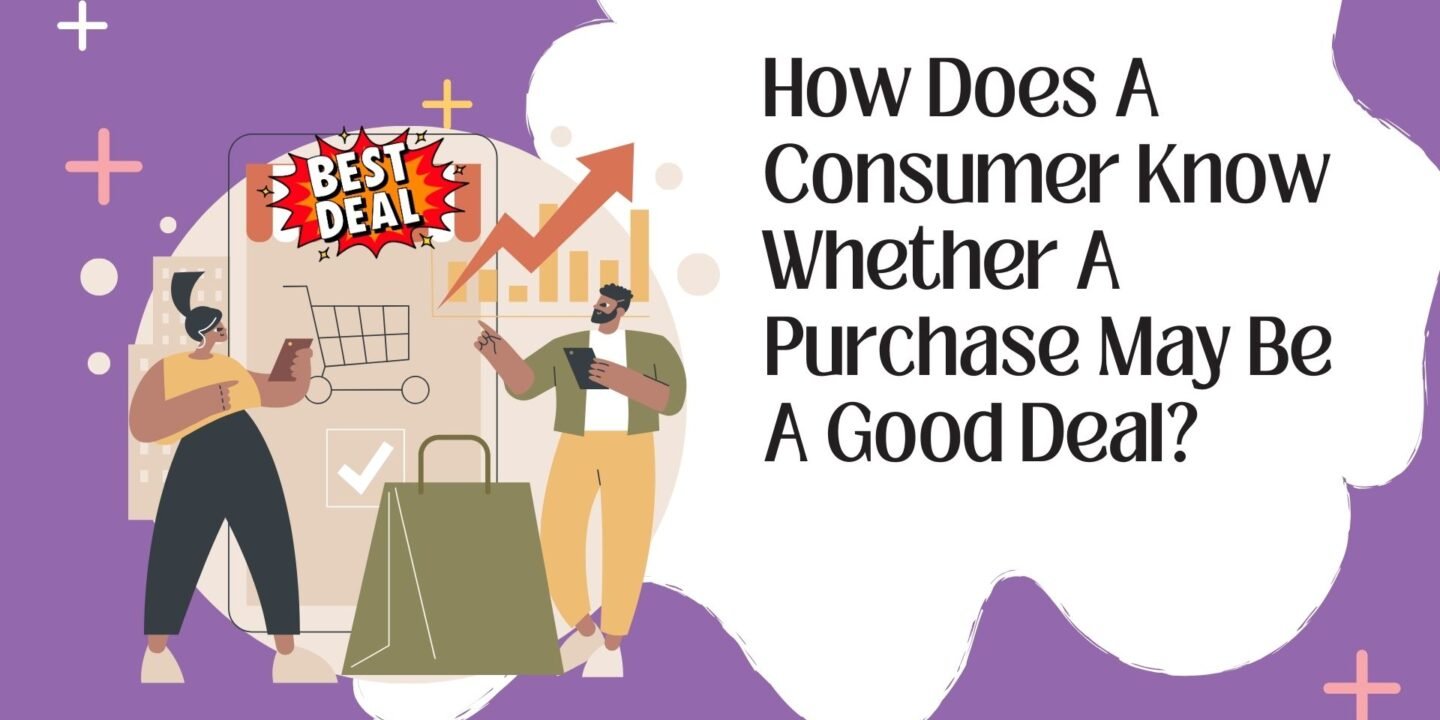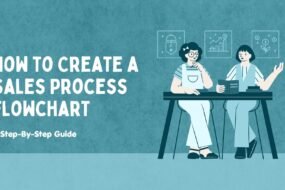
We’ve all been there—standing in a store aisle or scrolling through an online shop, wondering, Is this really worth it? Making a purchase decision often feels like a mix of logic, instinct, and a dash of hope. But how do you truly know if you’re getting a good deal?
Whether you’re shopping for a new gadget, a much-needed service, or even groceries, understanding what defines a “good deal” can save you money, time, and regret. In this blog, “How does a consumer know whether a purchase may be a good deal?” we’ll break down the factors that help consumers make smarter purchasing choices. From evaluating product quality to understanding price comparisons and sales tactics, you’ll learn the secrets to becoming a more confident, savvy shopper.
What Makes A “Good Deal”?

A good deal isn’t just about paying the lowest price—it’s about getting the most value for your money. To determine this, consider these key elements:
- Price Relative to Market Value: Is the price competitive or significantly lower than usual? A quick market analysis can help you decide.
- Product Quality: A cheap product with poor durability isn’t a good deal. Assess materials, warranties, and brand reputation.
- Personal Need and Use: Even the best deal is a waste if you don’t actually need or use the product.
- Timing of the Purchase: Seasonal discounts, holiday sales, and clearance events often offer the best deals.
- Hidden Costs: Look beyond the sticker price for shipping fees, installation costs, or maintenance expenses that could add up.
- Return and Refund Policies: Ensure the seller offers flexible return or refund options in case the product doesn’t meet your expectations.
- Customer Reviews and Ratings: User reviews provides insight into a product’s performance and reliability.
- Longevity and Durability: A durable product may cost more initially but saves money over time.
- Comparison Shopping: Always compare prices and features across sellers or brands to ensure you’re getting the best value.
Determining whether a purchase is a good deal involves evaluating several factors that indicate value for money. Here’s how consumers can assess whether a purchase is worth it:
Compare Prices
Importance of Comparing Prices
- Comparing prices is essential to ensure you get the best value for your money. Different retailers may sell the same product at varying prices, and a little research can save you a significant amount.
- Price discrepancies often arise due to factors like location, stock availability, and promotional strategies.
How to Compare Prices Effectively
- Use price comparison websites like Google Shopping, PriceGrabber, or ShopSavvy to view multiple offers in one place.
- Check both online and offline retailers. Some brick-and-mortar stores may offer in-store-only deals.
- Monitor price trends over time, especially for expensive items like electronics or appliances.
Cautions While Comparing Prices
- Watch out for additional costs like shipping fees, taxes, or installation charges that may not be included in the listed price.
- Be wary of price-matching guarantees. Always read the fine print, as some stores may exclude certain promotions or brands.
Example in Action
- If you’re buying a washing machine, compare prices on Amazon, Best Buy, and local appliance stores. Check if any retailer offers free delivery or extended warranties to enhance the deal.
By investing time in price comparison, you can confidently identify the best deal without sacrificing quality.
Look For Discounts And Offers
Why Discounts Matter
- Discounts and offers provide significant savings, especially during festive seasons or clearance sales. Leveraging these can reduce costs without compromising on quality.
Where to Find Discounts
- Check retailer websites and subscribe to newsletters for exclusive deals.
- Use discount apps like Rakuten, or RetailMeNot to track promo codes and cashback offers.
- Look for in-store loyalty programs or credit card benefits offering discounts or reward points.
Tips for Smart Shopping with Discounts
- Avoid impulse purchases just because something is on sale. Ensure the discounted item meets your needs.
- Compare the discounted price with similar products to ensure you’re still getting a good deal.
- Verify the authenticity of discounts. Some retailers inflate prices before applying discounts to create an illusion of savings.
Example in Action
- During Black Friday, a retailer may advertise a laptop at a 40% discount. Compare its specs and discounted price with competitors to confirm the value.
By strategically using discounts and offers, you can make significant savings while shopping wisely.
Evaluate Product Value
Understanding Product Value
- The true value of a product lies in its quality, features, and durability. Paying a low price for a subpar product isn’t a good deal.
- Consider how long the product will last and whether it fulfills your intended purpose.
Steps to Evaluate Value
- Compare features with similar products in the same price range.
- Assess the brand’s reputation for quality and reliability.
- Check if the product offers additional perks, such as warranties or after-sales service.
What to Avoid
- Don’t be swayed by marketing gimmicks or flashy packaging. Focus on functionality and performance.
- Avoid products that are significantly cheaper but lack essential features or durability.
Example in Action
- When purchasing headphones, compare brands like Bose and Sony. Evaluate sound quality, comfort, and battery life to determine the better value for your needs.
Focusing on value ensures your money is spent wisely and that the product delivers satisfaction over time.
Read Reviews And Ratings
Why Reviews and Ratings Matter
- They provide real-world feedback from other consumers, highlighting the product’s strengths and weaknesses.
- Reviews often reveal insights about long-term performance and customer service experiences.
How to Use Reviews and Ratings
- Focus on detailed reviews that explain specific pros and cons.
- Prioritize verified buyer reviews, as these are less likely to be fake.
- Check multiple platforms, including Amazon, Best Buy, or specialty forums, for diverse perspectives.
Cautions When Reading Reviews
- Be skeptical of overly positive or negative reviews, as they may be biased or paid promotions.
- Look for consistent feedback patterns to identify genuine issues or benefits.
Example in Action
- Before purchasing a vacuum cleaner, read reviews to understand suction power, ease of maintenance, and noise levels.
By leveraging reviews and ratings, you can make informed decisions and avoid potential disappointments.
Consider Timing
Why Timing Affects Deals
- Retailers often offer significant discounts during specific times, like holidays, end-of-season sales, or clearance events.
- Being strategic about timing can help you secure better deals without rushing.
Tips for Smart Timing
- Wait for annual sales like Black Friday, Cyber Monday, or Prime Day for significant discounts.
- Purchase seasonal items during off-seasons for lower prices. For instance, buy winter coats in spring.
- Monitor price drops using tools like CamelCamelCamel or PriceBlink.
What to Avoid
- Avoid buying products immediately after their launch, as prices tend to be higher.
- Don’t rush into sales without researching if the discount is genuine.
Example in Action
- If you need a new refrigerator, consider waiting for Memorial Day or Labor Day sales when appliances are often discounted.
Timing your purchases wisely can lead to substantial savings while ensuring you get what you need.
Understand The True Cost
What is the True Cost?
- The true cost of a product includes the purchase price and any additional expenses like shipping, taxes, or maintenance.
- Overlooking these factors can lead to unexpected expenses and diminish the value of a deal.
How to Identify the True Cost
- Factor in delivery charges, taxes, and setup fees before finalizing your purchase.
- Consider long-term costs like energy consumption, repairs, or replacements.
- If buying on credit, calculate interest and total repayment costs.
Cautions When Calculating Costs
- Be wary of “too good to be true” deals that may have hidden fees.
- Check warranty terms to avoid surprise costs for repairs or replacements.
Example in Action
- A $300 printer may seem affordable, but if its ink cartridges cost $50 each and require frequent replacement, it may not be cost-effective.
Understanding the true cost ensures transparency and helps you make better financial decisions.
Assess Personal Needs
Why Personal Needs Matter
- A good deal is only valuable if it aligns with your specific requirements. Buying something just because it’s cheap may lead to regret.
- Prioritizing needs ensures that your purchase adds value to your life rather than becoming clutter.
How to Reflect on Needs
- Identify what you need versus what you want. Focus on practicality over luxury.
- Evaluate whether the product’s features meet your everyday requirements.
What to Avoid
- Avoid being swayed by advertisements or peer pressure to buy unnecessary items.
- Don’t compromise on essential features just to save money.
Example in Action
- If you need a car for commuting, prioritize fuel efficiency and reliability over luxury features like sunroofs or leather seats.
By focusing on personal needs, you ensure that every purchase serves a meaningful purpose.
Frequently Asked Questions
Q1. How does a consumer know when a purchase may be a good deal?
Ans. Consumers consider factors like price comparisons, discounts, reviews, and the item’s quality. If the purchase aligns with their budget, needs, and perceived value, they often deem it a good deal.
Q2. How do consumers decide whether to purchase a good?
Ans. Consumers evaluate their needs, budget, alternatives, and the product’s value. Emotional appeal, brand reputation, and external influences like advertising or peer recommendations also play a key role in their decision-making.
Q3. When a consumer purchases a good, what does this reveal?
Ans. A purchase reveals the consumer’s preference, perceived value of the good, and alignment with their needs, desires, or budget. It indicates the buyer’s prioritization of the product over other available options.
Q4. What factors determine whether a consumer decides to purchase a good or service?
Ans. Key factors include price, quality, brand reputation, urgency of need, peer reviews, emotional appeal, and availability. Marketing strategies, discounts, and the consumer’s financial situation also significantly influence the decision.
Q5. How do you know if something is a good purchase?
Ans. A purchase is good if it meets your needs, is within budget, and offers quality and value compared to alternatives. Positive reviews, durability, and satisfaction post-purchase are strong indicators of a good buy.
Conclusion
A good deal is a combination of price, quality, and relevance to your needs. By taking the time to research, compare, and evaluate your options, you can confidently make purchases that align with your financial goals and personal preferences. Remember, the smartest shoppers aren’t the ones who find the lowest prices but those who make the most informed decisions.
Whether it’s leveraging online reviews, timing purchases strategically, or using budgeting tools, these tips empower you to navigate the shopping landscape with confidence. Happy deal hunting!








No Comments